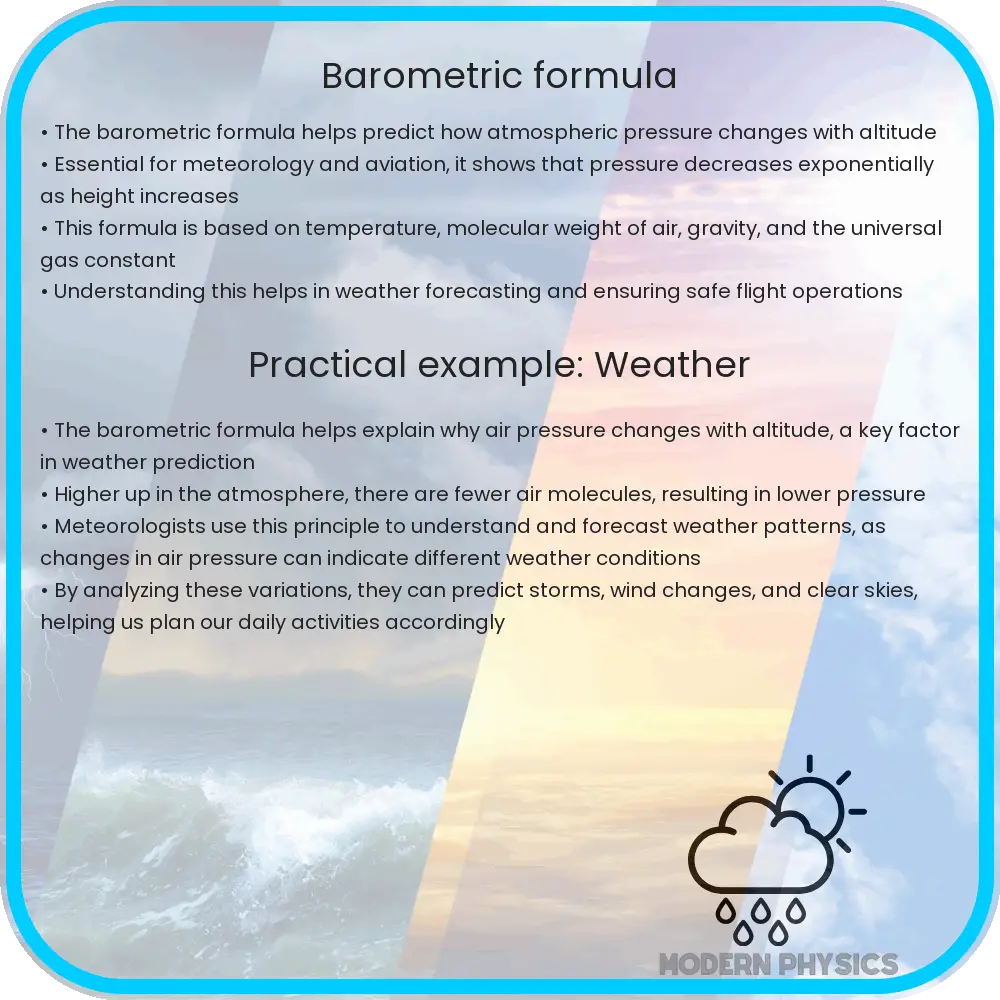Explanation of the Barometric Formula, a scientific equation used to calculate atmospheric pressure changes with altitude, considering factors like temperature and molar mass.

Understanding the Barometric Formula: Altitude, Pressure, and Temperature
The Barometric Formula is a fundamental concept in atmospheric physics, providing a way to estimate the change in air pressure with altitude. It is an essential tool not just for meteorology, but also in aviation, mountaineering, and several engineering applications.
Basics of the Barometric Formula
The atmosphere is a layer of gases surrounding the Earth, held in place by gravity. As one moves higher in elevation, the density of the air and subsequently the air pressure decreases. The barometric formula helps quantify this decrease by relating atmospheric pressure to altitude under the assumption of a constant temperature throughout the layer of the atmosphere considered.
The basic form of the Barometric Formula is:
P = P0 * exp(-Mgh / RT)
Where:
- P is the pressure at height h,
- P0 is the reference pressure at the base altitude,
- M is the molar mass of Earth’s air,
- g is the acceleration due to gravity,
- R is the universal gas constant,
- T is the absolute temperature in Kelvins.
This equation is derived from the hydrostatic equation in fluid dynamics, integrated over a vertical height with the ideal gas law assumed to be valid. Understanding each component deeply gives profound insights into how atmospheric conditions change with elevation.
Factors Affecting Atmospheric Pressure with Altitude
The primary factor affecting atmospheric pressure is altitude. However, a few more elements significantly influence how pressure behaves in the atmosphere:
- Temperature: The Barometric Formula above assumes the temperature (T) is constant, which is a simplification. In reality, the temperature can decrease or increase with altitude, affecting the rate of pressure decrease.
- Gravity: Variations in Earth’s gravity with latitude and altitude slightly alter the values of g in the formula, impacting the calculated pressures.
- Composition of the Air: Varying concentrations of gases (like water vapor) in the atmosphere can change the average molar mass (M), affecting the density and pressure.
Due to these factors, more comprehensive models such as the International Standard Atmosphere (ISA) and others have been developed to provide more accurate predictions by including layers where temperature does change with altitude.
Applying the Barometric Formula
In practical terms, the Barometric Formula is utilized in several areas including:
- Aviation: Pilots use altitude and pressure information for navigation and for understanding how weather conditions will affect their flight.
- Mountaineering: Climbers may use devices that measure atmospheric pressure to estimate their altitude and predict weather changes.
- Engineering: Civil and aerospace engineers need accurate atmospheric data to design structures and vehicles that can operate efficiently at different altitudes.
Each application relies on accurate interpretation of the Barometric Formula to ensure safety and functionality across varying conditions.
Impact of Altitude on Human Physiology and Equipment
Aside from its applications in fields like aviation and engineering, the Barometric Formula also has implications for human physiology and the performance of various equipment. As altitude increases and atmospheric pressure decreases, the amount of oxygen available in the air diminishes. This phenomenon can lead to altitude sickness in humans and affects the efficiency of combustion engines and other equipment that rely on atmospheric air.
Understanding the principles dictated by the Barometric Formula can help in developing measures to mitigate these effects, such as designing engines that compensate for lower oxygen levels or medical protocols to assist in acclimatization to high altitudes.
Technological Advancements and the Barometric Formula
Technological advancements have enabled more precise measurements and predictions related to atmospheric pressure. The development of sophisticated sensors and meteorological satellites has enhanced the accuracy of data collected, thus refining the applications of the Barometric Formula. These technologies not only improve safety and efficiency in aviation and engineering but also contribute significantly to weather forecasting and climate science.
With ongoing research and technological enhancements, modifications to the current models of the Barometric Formula are anticipated. These adaptations will better account for the complex behaviors of the atmosphere, particularly in extreme conditions or at very high altitudes.
Conclusion
The Barometric Formula is a key component in understanding how atmospheric pressure changes with altitude. From its theoretical bases in physics to its diverse real-world applications, this formula plays a critical role in various sectors such as meteorology, aviation, and engineering. By quantifying how pressure varies with altitude, it provides essential insights that are crucial for safe and efficient operations in many fields.
Moreover, as technology continues to evolve, the precision and utility of the Barometric Formula are likely to improve, leading to even more effective applications. Whether it is assisting pilots in navigating the skies, helping climbers gauge mountainous conditions, or enabling engineers to design better systems, the importance of the Barometric Formula cannot be overstated. It remains an indispensable tool in both understanding our atmosphere and managing our activities within it.
